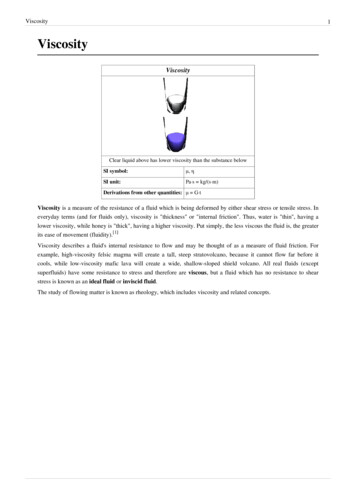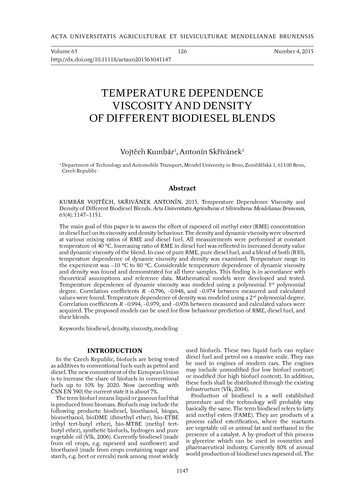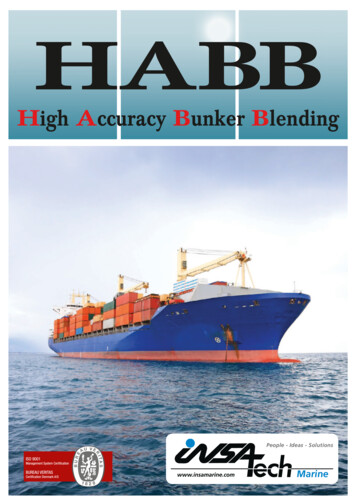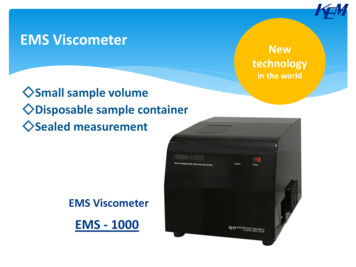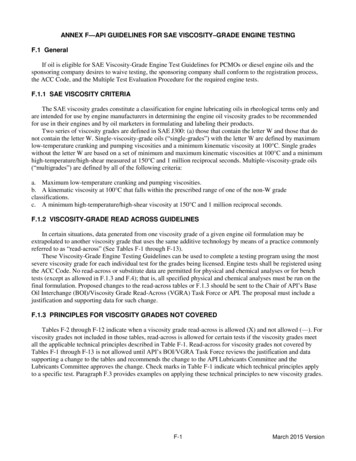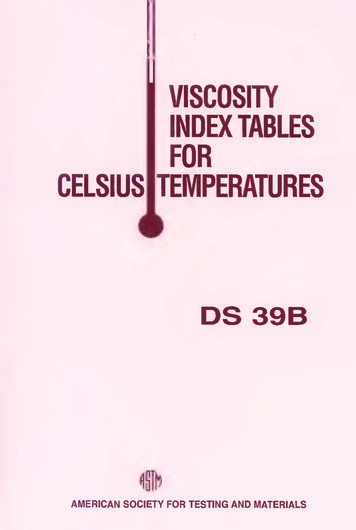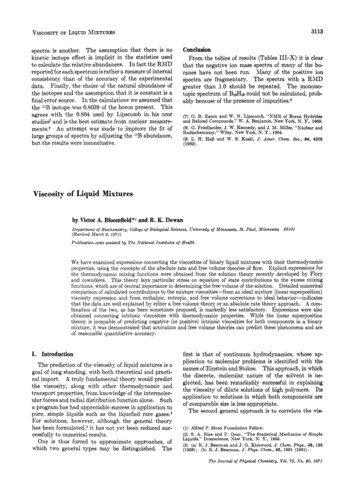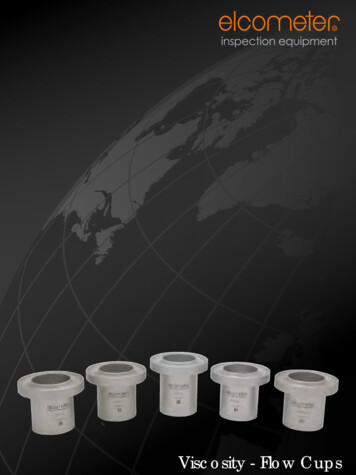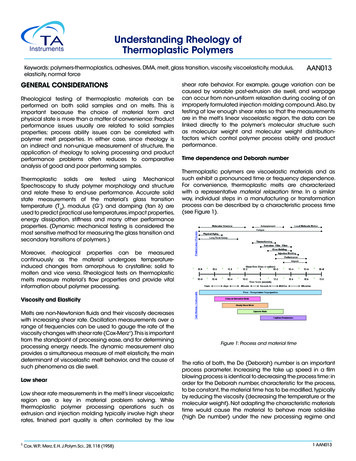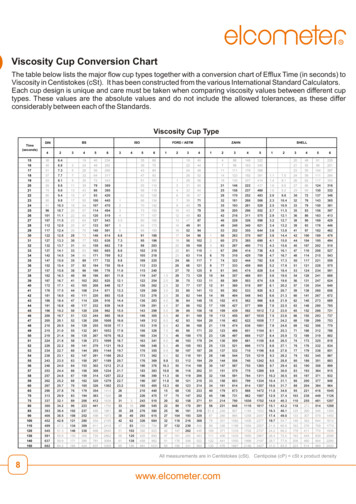
Transcription
Elongational Viscosity of Monodisperseand Bidisperse Polystyrene MeltsJens K. Nielsen, Henrik K. Rasmussen,Ole Hassager, and Gareth H. McKinleyMarch 2006HML Report Number 06-P-06@http://web.mit.edu/fluids
Elongational viscosity of monodisperse and bidispersepolystyrene meltsJens Kromann Nielsen 1 ,Henrik Koblitz Rasmussen 2 and Ole HassagerThe Danish Polymer CentreDepartment of Chemical Engineering 1Department of Manufacturing Engineering and Management 2Technical University of DenmarkDK-2800 Kgs. Lyngby, Denmark1Gareth H. McKinleyHatsopoulos Microfluids LaboratoryDepartment of Mechanical EngineeringMassachusetts Institute of TechnologyCambridge, Massachusetts 02139, USAAbstractThe startup and steady uniaxial elongational viscosity have been measured for two monodisperse polystyrene melts with molecular weights of 52 kg/mole and 103 kg/mole, and for threebidisperse polystyrene melts. The monodisperse melts show a maximum in the steady elongational viscosity vs. the elongational rate, ǫ̇, of about two times 3η0 whereas the bidispersemelts have a maximum of up to a factor of 7 times the Trouton limit of 3η0 . The Wiestmodel which incorporates anisotropic drag and finite extensibility may be used to interpretthe results in molecular terms.1
1IntroductionThe scaling of linear viscoelastic properties such as the zero shear viscosity, η0 and the characteristic reptation time , τd , for the Doi-Edwards model (Doi and Edwards, 1986) have beeninvestigated thoroughly both theoretically and experimentally in the literature for monodispersepolymer melts. It is commonly accepted that the zero shear viscosity and the reptation time bothscale with the molecular weight as η0 M 3.4 and τd M 3.4 for monodisperse polymers withmolecular weights substantially above the entanglement molecular weight, M (2 4)Me . Elongational flow properties have however not been analyzed as intensely. Thorough investigation ofthe elongational viscosity for very diluted solutions of monodisperse (and bidisperse) polystyrenehave been made and analyzed by Gupta et al. (2000) and Ye et al. (2003). Wagner et al.(2005) have recently published elongational results for bidisperse blends of small amounts of ultrahigh, narrow molecular weight polystyrene ,Mw 3220 Kg/mole and Mw 15400 Kg/mole in lowermolecular weight polydisperse polystyrene, Mw 423 Kg/mole. Steady state was never reached,but the authors found that the blends were more strain hardening than the monodisperse melts,and that maximum amount of strain hardening increased with increasing content of ultra highmolecular weight polystyrene. To our knowledge the only published steady elongational viscosities for monodisperse melts are those of Bach et al. (2003a) and Luap et al. (2005). Neither theDoi-Edwards model nor other reptation-based models (Marrucci and Grizzutti (1988), Mead et al.(1998), Fang et al. (2000), Ianniruberto and Marrucci (2001), Schieber et al. (2003)) have effectively been able to predict the flow behaviour of especially high Deborah-number flows, i.e. fastelongational flows with ǫ̇ 1/τd . Indeed, the major limitation to progress in the understanding ofthe nonlinear properties in elongational flow seems to be the scarcity of data for well-characterizednarrow molecular weight linear polymer melts.There have been a number of recent efforts at extending the basic reptation picture to incorporate additional physical mechanisms that modify the evolution in the polymeric stress in strongstretching flows. These include incorporating the role of ’intrachain pressure’ within a differentialframework (Marrucci et al. 2004) and within the integral molecular stress function formulation( Wagner et al. 2005) or through detailed analysis of the rate of creation and destruction of’slip links’ (Likhtman 2005). The key change that each of these models seek to incorporate isa modification in the scaling of the steady elongational steady stress with the elongational rate,σzz σrr ǫ̇n . The bare reptation model of Doi and Edwards predicts a saturation in the stress,n 0 (corresponding to thinning in the elongational viscosity). Incorporation of chain stretchingresults in unbounded stress growth, which can be truncated through considering the finite extensibility of the chains resulting ultimately in n 1 (Fang et al. 2000) corresponding to finite limitingvalue of the elongational viscosity. The proposed models by Marrucci and Ianniruberto (2004)and Wagner et al. (2005) both find that n 0.5. In the present work we use the simple modelproposed by Wiest (1989) which models the effects of the surroundings chains as an anisotropicdrag acting on a finitely-extensible dumbbell that represents a single segment of the orientingand elongating chain. This computationally simple model gives n 0.5 and we show below thatit is able to capture many of the important features that we observe in the steady elongationalviscosity.Bach et al. (2003a) measured the elongational viscosity of two narrow molar mass distributionpolystyrene melts, with Mw 200 kg/mole, PS200K, and Mw 390 kg/mole, PS390K. The mainconclusions drawn from this work were: 1) The steady elongational viscosity for Deborah numbers,defined as De ǫ̇τd greater than unity scales as η̄ ǫ̇ 0.5 . 2) The steady elongational viscosityscales linearly with the molecular weight for De 1, i.e. η̄ Mw ǫ̇ 0.5 and finally 3) the steadyelongational viscosity is a monotone decreasing function of the elongational rate. That is, η̄ doesnot exceed 3η0 for any elongational rate accessed experimentally. The authors did point out,2
that their conclusions with regard to molecular mass scaling were based on merely two samples.Based on the scaling properties of η0 and τd with the molecular weight it is however realizedthat these conclusions cannot be true if one extends them to elongational measurements of lowermolecular weights. There are simply too many constraints. Marrucci and Ianniruberto (2004)have treated this problem theoretically and suggested that melts with fewer entanglements mayshow a maximum in η̄ as function of ǫ̇.The first purpose of this work is to investigate how two polystyrene melts with Mw 103 kg/mole,PS100K, and Mw 52 kg/mole, PS50K, behave in a uniaxial elongational flow at 130 C. Polystyrenehas an entanglement molecular weight of Me 13.3kg/mole (Fetters et al., 1994), giving the meltsrespectively 7.7 and 3.9 entanglements. With these fluids it is possible to analyze what happensto η̄ in the transition going from low to high Deborah numbers, i.e. from the linear to the nonlinearly dominated regime. The elongational measurements can give an indication of which of theconstraints noted above must be relaxed.The reptation time for PS100K is τd 100s at 130 C. The range over which the elongationalrates can be measured by the filament stretching rheometer (FSR) to avoid dissipative heating inthe sample is ǫ̇ 0.3s 1 (Bach et al. 2003a), making it possible to transition from low to highDeborah numbers for PS100K. The lower molecular weight PS50K sample is expected mostly toprovide information about the linear region, since τd 10s.The lack of a maximum in η̄ vs. ǫ̇ for PS200K and PS390K is believed to be related to themonodisperse character of the melts, and it has therefore been decided to make three bidispersemelts, in which each of the individual polymers in the blend are expected not to display a maximumin η̄ vs. ǫ̇ when studied in isolation. We have decided to mix PS390K with PS50K in two differentconcentrations in order to investigate the effect of diluting PS390K with PS50K. Secondly we havemade a mixture of PS390K with PS100K, where PS390K has the same mass-concentration as oneof the PS390K PS50K-blends.The composition of the three blends used in the work is shown in table 1. In this table wealso show the concentration of PS390K relative to the overlap concentration, c*, of PS390K in adilute solution under theta conditions defined by Doi (1992) (page 20). The radius of gyrationRg for PS390K is found to be Rg 168nm, (Fetters et al., 1994), and since one polymer hasa volume of order O(Rg3), the overlap concentration of PS390K is found to be c* 16kg/m3 , orc* 1.6w/w%. We also specify in table 1 the weight-average molecular weight of the bi-disperseblends, Mw φL ML φS MS where φi and Mi are the weight fractions- and the molecular weightsof the long chain (L) and short chain (S) components.22.1Experimental sectionSynthesis and ChromatographyThe two polystyrene samples PS50K and PS100K were synthesized by anionic polymerisation(Ndoni et al. 1995). The molecular weights were determined by size exclusion chromatography(SEC) with toluene as the eluent using a Viscotec 200 instrument equipped with a PLguard andtwo PLgel mixed D columns in series (from Polymer Laboratories) using a RI detector. On thebasis of calibration with narrow molecular weight polystyrene standards, the values of Mw andMw /Mn were measured for the monodisperse samples. The results are given in table 2.2.2Mechanical SpectroscopyThe viscoelastic properties of the polystyrene melts were obtained from small amplitude oscillatoryshear flow measurements on an AR2000 rheometer from TA instruments using a plate-plate ge3
ometry (see figure 1 and 2). The measurements were performed at 130 C for the PS50K, PS100Kand blends, and at 150 C for the blends. The measured data at 150 C was shifted to 130 C usingthe time temperature superposition shift factor aT found from the WLF-equation (Bach et al.2003a): c0 (T T0 )log10 (aT ) 0 1(1)c2 (T T0 )where c01 8.86, c02 101.6 C, T0 136.5 C and T is the sample temperature in C.2.3Transient elongational viscosity measurementsThe transient elongational viscosity was measured using a filament stretching rheometer which isdescribed in detail elsewhere (Bach et al. 2003b). The polystyrene melts were dried according tothe protocol of Schausberger and Schindlauer (1985), and moulded into cylindrical-shaped samples,with radius of Ri 4.5mm and height of Li 2.5mm using a Carver hydraulic press. The PS50Kand PS100K-samples were pressed at 150 C and annealed at this temperature for 2 minutes.The bidisperse blends were pressed and annealed for 2 minutes at 170 C. The temperatures werechosen to ensure that the polymer chains were completely relaxed and still did not degrade;this was confirmed using SEC after the elongational experiment was performed. The mouldedpellets were placed between two parallel plates inside the filament stretching rheometer, and thetemperature was raised to 130 C. To ensure adhesion between the end plates and polymer melt, theend plates were coated with a solution of polystyrene in tetrahydrofuran as described in Bach et al.(2003a). In most of the experiments performed the sample was pre-stretched in order to reducethe transmitted force in the vertical plane to avoid the sample being ripped of the end plates.All samples was pre-stretched by variable amounts, thus the initial radius for experiments withPS100K at ǫ̇ 0.3s 1 was R0 1.5mm, whereas the initial radius for Blend 3 was R0 4.3mmat ǫ̇ 0.00015s 1. The pre-stretch was performed with stretch rates considerably lower than theinverse of the longest relaxational time. The melt is allowed to relax before every elongationalexperiment is started. We wait until all residual orientation in the polymer has disappeared, whichis the case when no residual forces are present as indicated by the load cell. This equilibrationtime is at least ten times the longest relaxation time of the melt.During a stretching experiment a laser micrometer samples the central diameter of the elongating filament while a load cell measures the force at the end plate. The diameter data is sentdirectly to a controller that produces a signal to the motor pulling the end plates apart. Thiscontrol method ensures that the radius decreases exponentially with time as R(t) R0 e ǫ̇t/2 . TheHencky strain is defined as ǫ 2 ln(R(t)/R0 ). After an elongational experiment is complete, themeasured radius R(t) and force F (t) are used to calculate the tensile stressσzz σrr F (t) m1 gπR(t)2(2)σzz σrrǫ̇(3)and the transient elongational viscosity as:η̄ (t) where the measured force, F , is corrected by the weight of lower half of the polymer filament, m1and the gravitational acceleration g (Szabo 1997). This weight is measured by forcing the filamentto break at the symmetry plane after the end of an experiment.At small strains there is an extra force contribution from the shear components in the deformation field during start-up. The shear component originates from the no slip condition at the rigidend plates and is especially important at small aspect ratios. For Newtonian fluids this reverse4
squeeze flow problem can be modelled analytically and the effect of the additional shear may beeliminated by a correction factor (Spiegelberg and McKinley (1996)). 1exp( 7ǫ ǫ0 )/3) 1 η̄corr η̄(4)3Λ2iwhere Λi Li /Ri is the initial aspect ratio, ǫ0 is the pre stretched Hencky strain, defined as ǫ0 2 ln(R0 /Ri ) and η̄corris the corrected transient uni-axial elongation viscosity.This correction is analytically correct for very small strains (ǫ 0) for all types of fluids.However, the correction is less accurate at increasing strains where the effect of the correctionfortunately vanishes.In this work we have chosen to present the elongation measurements in both uncorrected andcorrected form, as we also prefer to present the raw data. For the aspect ratio used here, the extraforce contribution is negligible after about one additional strain unit . This was demonstratedexperimentally in Bach et al. (2003b), and theoretically in Kolte et. al. (1997) for polymer melts.Eriksson and Rasmussen (2005) suggest that the relevant non-dimensional measure of thesurface tension in pviscoelastic flow is the ratio of the surface tension stresses to the complex modulus G (ω) G′ (ω)2 G′′ (ω)2 , i.e. Vc σ/(RG (ǫ̇)), where the angular frequency, ω, hasbeen replaced with the characteristic deformation rate, ǫ̇. This Viscoelastic Capillary numberresembles the surface elasticity number, (Spiegelberg and McKinley (1996) and Rasmussen andHassager (2001)) at high deformation rates and the inverse of the classical Capillary number atlow deformation rates. As Vc stays below 0.03 in all experiments, the effect of surface tension isnegligible.The effect of gravitational sagging can be evaluated using a relevant measure of the magnitudeof gravitational forces relative to the viscous forces. Here we use the ratio Li exp(ǫ ǫ0 ) ρg/(2ǫ̇η̄ )as in Rasmussen et al. (2005) where ρ is the density of the polymer melt. The duration of theelongational experiments in this work were considerably below the sagging time, as this numberis less than 0.1 in all the performed experiments.See Szabo and McKinley (2003) for additional discussion of similar correction factors.3Linear Viscoelastic MeasurementsA linear viscoelastic (LVE) analysis provides us with an estimate of the elongational behaviourin the limit De 0 and provides a verification of the reliability of the elongational experimentsespecially at short times and small strains. If the verifications of the experiments were the solepurpose of doing LVE-experiments a simple Maxwell-fit to the data would be sufficient. But wealso seek to determine the characteristic time constants of the individual polymeric species in themelt, and for this the Baumgaertel, Schausberger and Winter (BSW) model is used (Baumgaertelet al. 1990). Each polymer contributes a distinct spectrum with a characteristic time constant.We analyse the LVE-data with a theoretical approach suggested by Jackson and Winter (1995)which handles mono- and bidisperse melts. This is not to be confused with a blend rule, sincethe LVE-properties of the blends cannot be predicted from the composition of long- and shortpolymers by this procedure. The LVE properties of monodisperse linear polymers (Milner andMcLeish, 1998) and mixing rules for blends of monodisperse species (des Cloizeaux (1988)) havebeen studied in detail. In terms of physical insight the BSW-approach is not far from a simpleMaxwell-fit, with few exceptions as described later.The relaxation modulus G(t) is found from the continuous-spectrum H(λ), which for thebidisperse blends is composed of two individual spectra:5
G(t) G1 (t) G2 (t)Z Hi (λ)Gi (t) exp( t/λ)dλ, i 1, 2λ0" ne ng #λλHi (λ) ne G0N,i h(1 λ/λmax,i )λmax,iλc(5)(6)(7)Here h(x) is the Heaviside step function, ne is the slope of the (log(ω), logG′) curve at intermediatefrequencies ω, ng is the slope of (log(ω), log G′′ ) for ω , and λc is called the crossover relaxationtime. We constrain the individual contributions to the modulus in a way such that G0N G0N,1 G0N,2 is constant.When least-squares fitting (Rasmussen et al. 2000) the BSW model to the LVE data, ne , ng(both independent of temperature), λc and G0N are treated as fixed values. The cross over timeλc depends on temperature as any other relaxation time. ne 0.23, ng 0.67 and λc 0.4s (at130 C) as obtained by Jackson and Winter (1995). The value of G0N was found by Bach et al.(2003a) to be 250 kPa at 130 C, and we have decided to use this value as a fixed parameter. Thismeans, that the only remaining adjustable parameters to model the LVE data are the two largestrelaxation times, λmax,1 and λmax,2 as seen in table 3.Since the monodisperse melts only have one largest time constant λmax , this is the singleadjustable parameter for fitting the LVE data for PS50K, PS100K and PS390K to the BSWmodel. In order to be able to compare the properties of monodisperse and bidisperse melts, thesame values of ne , ng and λc are always used. The model parameters are given in table 3, obtainedby least squares fitting the measured values of G′ and G′′ . The experimental results for G′ andG′′ are shown in figures ? and ? together with the best fit of the BSW-model. The zero shearviscosities are calculated as:η0,i Z0 Gi (s)ds ne G0N,i λmax,i11 1 ne 1 ng λmax,iλc ng !(8)For the monodisperse melts i 1. For the bidisperse melts i 1, 2, and the individual η0,i canbe added to find the actual, measured value of η0 η0,1 η0,2 .Fitting η0 for the monodisperse melts PS50K, PS100K, PS200K and PS390K with the molecular weight as a power law, the exponent is found to be 3.38 as generally observed for thesemoderately entangled systems.The average reptation time is calculated as:R Gi (s)sds1 ne0λa,i R λmax,i(9)2 neGi (s)ds0This expression applied to the Doi Edwards relaxation modulus gives a value that is within 2%of the commonly denoted reptation time, τd . This time is found to scale with molecular weight asλa M 3.52 for our monodisperse melts.The characteristic time constants for the bidisperse systems found in Table 3 show that thesmaller time constant in the blend is more or less unchanged compared to the time constant forthe undiluted small molecular weight melt. This is in agreement with the expectation (Doi et al.1987) that there will be no tube dilation for the short chains. By contrast the longest relaxationtime in the blend has been significantly reduced compared to the longest relaxation time for anundiluted melt of long chains which is attributed to the effect of tube dilation, Doi et al. (1987).6
Struglinski and Graessley (1985) have predicted that when the molar masses in a binary blendof short (Ms ) and long (Ml ) chains are far apart, the reptation time for the longest moleculesshould not depend on the blend composition. The relevant constraint release parameter is definedas Gr ML Me2 /MS3 with the prediction that the reptation time of the longer chains should beunchanged provided Gr 0.1. More recent investigations (Lee et al. 2005 and Park et al. 2004),however, suggest that the critical condition is somewhat lower with Grc 0.064 such that thenon-dilation regime is limited to Gr Grc . The constraint release parameters for our blends(shown in Table 1) are indeed all larger than Grc indicating that tube dilation takes place andthat relaxation of the stress carried by the long chains is the result of constraint release due toreptation of the short chains. This is reflected in the values of λa,2 for the blends compared to thevalue λa,1 for the pure long chains (PS390K) in table 3. By contrast the short relaxation time ofblend (λa,1 ) is substantially unchanged compared to that of the pure short chains indicating thatthe short chains are reptating in an essentially frozen network of long chains. Moreover accordingto the revised Struglinski and Graessley criterion our blend 3 should be the least affected by tubedilation also in agreement with observations.Struglinski and Graessley also conclude that the zero shear viscosity η0 for bidisperse meltsdepends on the weight average molecular weights as the monodisperse melts where η0 Mw3.4 .This prediction deviates less than 40 percent from our measured zero shear viscosities.Ye et al. (2003) used two monodisperse polystyrene samples of molar massesMs 2890 kg/mole and Ml 8420 kg/mole to prepare a series of bidisperse solutions spanning the range from pure short chains to long chains. All blends were dissolved intricresyl phosphate with an overall polymer volume fraction of 7%. These blends,all in the semidilute regime, were subsequently characterized in uniaxial extensionalflow and successfully compared to the predictions of a simplified reptation modeldesigned to investigate the effects of polydispersity. A characteristic feature of thesteady elongational viscosity is that all investigated solutions, including the monodisperse solutions show a transition to strain hardening and which is interpreted asa signature of chain stretching. In other words there was no qualitative differencebetween the measured elongational viscosity of the entangled monodisperse and bidisperse polystyrene solutions. The results obtained by Ye et al. are thus expected todiffer from our study for at least two reasons. Firstly, in Table 1 we show the valuesof the Struglinski-Graessley parameter Gr for the blends studied by Ye et al. Thewidely disparate values of the reptation times for the two species lead to Grc 1and indicate that, in contrast to our experiments, the dynamics of the longer chainshould remain unchanged regardless of the presence of the shorter species. Secondly,the materials studied by Ye et al. are semi-dilute entangled solutions rather thanmelts. Even though the number of entanglements is comparable, the higher molecular weight of each entangled segment when diluted by a solvent results in a greaternumber of Kuhn steps in each segment and consequently a larger molecular extensibility (Appendix 8.2).44.1Elongational Viscosity MeasurementsStartup of elongational flowFigures ?, ? and ? show the corrected transient elongational viscosity (equation ?) for PS50K,PS100K, Blend 1 and Blend 3 together with the LVE-prediction, all measured at 130 C. Theelongational measurements for all melts show good agreement with the LVE prediction at small7
strains. The deviation between the transient elongational data and LVE measurements is lessthan 15% in all measurements. Figures ?, ?, ? and ? show the same measurements as in theFigures ?, ? and ?, with uncorrected tensile stress differences (equation ?) plotted againststrain. It is seen, that the steady elongational viscosity is obtained for all elongational rates. Asthe elongational rate increases, the plateau region is maintained for fewer strain units comparedto smaller rates. This is due to a larger pre-stretch, ǫ0 , for the high stretch rate experiments. Thereason for increasing the pre-stretch in the faster experiments is two-fold. Firstly,it minimizes the magnitude of the correction for reverse squeeze flow (see eq.(4)).Secondly it helps reduce the tendency for deadhesion of the sample from the endplate.The adhesive force holding the sample to the end plate has a maximum value; by prestreching the sample to induce a neck at the midplane, higher tensile stresses (andhence higher maximum stretching rates) can then be tolerated in the middle of thefilament for a given force of adhesion at the end-plates.4.24.2.1Steady viscosity scaling at intermediate Deborah numbersMonodisperse meltsWe first turn our attention to the results for the monodisperse melts in order to compare withthe results from Bachs et al. (2003a). We see from figure ? and ? that the steady viscosity forPS100K reaches a value very close to 3η0 for the lowest elongational rate. The time dependenttransient viscosity, η̄ , for the lowest rate follows the LVE-prediction. At intermediate Deborahnumbers, i.e. 1 De 10, the steady elongational viscosity, η̄ rises above 3η0 . For PS100K η̄ isabout 50% above 3η0 , and the η̄-maximum is stretched over two decades of ǫ̇. The maximum forPS50K is measured to be at least 100% above 3η0 . It is possibly higher than 6η0 , since the highestmeasured elongational rate also gives the highest η̄ -value. The rate at which the maximumoccurs corresponds to a Deborah number around De 3 for both melts (assuming that η̄ reachesits maximum at a elongational rate somewhat higher than ǫ̇ 0.3s 1 for PS50K).The elongational viscosity measurements for PS100K and PS50K in the non linear regime,i.e De 3 are very limited because of the restriction due to dissipitative heating limiting themeasurements to ǫ̇ 0.3s 1 . There are only two measurements in the nonlinear regime availablefor PS100K, and none for PS50K. This makes it difficult to compare with the scaling behaviourproposed by Bach et al. (2003a).Bach et al. (2003a) claimed that the steady elongational stress scaled linearly with the molecular weight at high Deborah numbers. This scaling can be illustrated by interpretating dataaccording to recently published theory by Marrucci and Ianniruberto (2004). Figure ? showssteady values of (σzz σrr )/G0N vs. ǫ̇τp for all of the monodisperse melts. Here τp represents therelaxation time of the squeezing pressure effect as defined by Marrucci and Ianniruberto (2004).Marrucci and Ianniruberto report τp for PS200 to be τp 1000s, and the scaling is τp Mw2 .This is used to calculate τp for the other monodisperse melts, which then become: τp 66.8s forPS50K, τp 264.2s for PS100K and τp 3802.5s for PS390K. It is seen in figure ?, that thescaled values for PS50K and PS100K lie on the same line as the data for PS200K and PS390Ksteady state stresses, hereby showing that the linear scaling of steady stress with molecular weightat high Deborah-numbers is valid.Another conclusion from the work of Bach et al. (2003a) was that the steady elongationalviscosity scales with about ǫ̇ 0.5 for large Deborah numbers. By examining the raw-data fromBach et al. (2003a) more closely and performing a linear regression it is however concluded thatthe exponent is 0.42 0.03 within a 95% confidence interval. In the present study there areonly two measurements of η̄ for PS100K that could confirm this power law behaviour, and none8
for PS50K. Figure ? shows the steady elongational viscosity of PS100K, and it appears to showthe expected asymptotic behaviour.4.2.2Bidisperse meltsFigure ? and ? show the corrected transient elongational viscosity for the blends denoted Blend1 and Blend 3, see Table 1. It can be seen from both plots, that there is good agreement betweenthe elongational measurements and the LVE prediction for small strains. The steady viscosity liesubstantially above 3η0 for all measurements, except for Blend 3 at ǫ̇ 0.3s 1 .The complex interdependence of the transient extensional rheology of entangledblends on stretching rate, molecular weight and concentration is illustrated in Figure11 for the PS50K/PS390K blends. For a pure 50K melt at a strain rate of ǫ̇ 0.1s 1the transient extensional response closely follows the linear viscoelastic envelope.The addition of a small concentration of high molecular weight to the blend (Blend1; c/c* 2.5) results in a substantial transient strain-hardening and also a steadyextensional viscosity that is substantially above 3η0 for the blend. That this additionalstress is contributed by the higher molecular species can be easily demonstratedby examining the tensile stress contribution associated with a single mode UpperConvected Maxwell, (UCM) model (with modulus and relaxation time determinedfrom Table 3). This is shown by the dashed line in Figure ?. As the concentration ofhigher molecular weight species is increased to 14% (Blend 2) the magnitude of theextensional viscosity climbs further. Once again we show the contribution of the highmolecular weight species to the transient stress growth by plotting the response of anUCM model (solid line). The increase in the relaxation time of blend 2 also resultsin an increase in the Deborah number (Deblend2 1755s · 0.1s 1 176) and consequentlythe chains are fully elongated during the course of the experiment. This is illustratedby the horizontal dotted line in Figure 11 which corresponds to cutting off the stressgrowth for Blend 2 at a Hencky strain of ǫmax 12 ln(NK,seg ) 1.55s 1 , see appendix 8.2.Although the ultimate steady elongational viscosity shows some increase over 3 timesthe steady shear viscosity for this blend, it is clearly reduced substantially comparedto Blend 1. Finally we also show in Figure 11 the transient response of the purePS390K material at the same imposed stretch rate of 0.1s 1 , together with the UCMmodel (dashed dot line). The material shows an initial linear viscoelastic response,followed by strain-hardening but a steady elongational viscosity that is substantiallyless than 3(η0 ).Plotting the steady elongational viscosity against elongational rate in figure ?, ? and ? , itis seen that the maximum in elongational viscosity i
shear flow measurements on an AR2000 rheometer from TA instruments using a plate-plate ge-3. ometry (see figure 1 and 2). . The transient elongational viscosity was measured using a filament stretching rheometer which is described in detail elsewhere (Bach et al. 2003b). The polystyrene melts were dried according to
